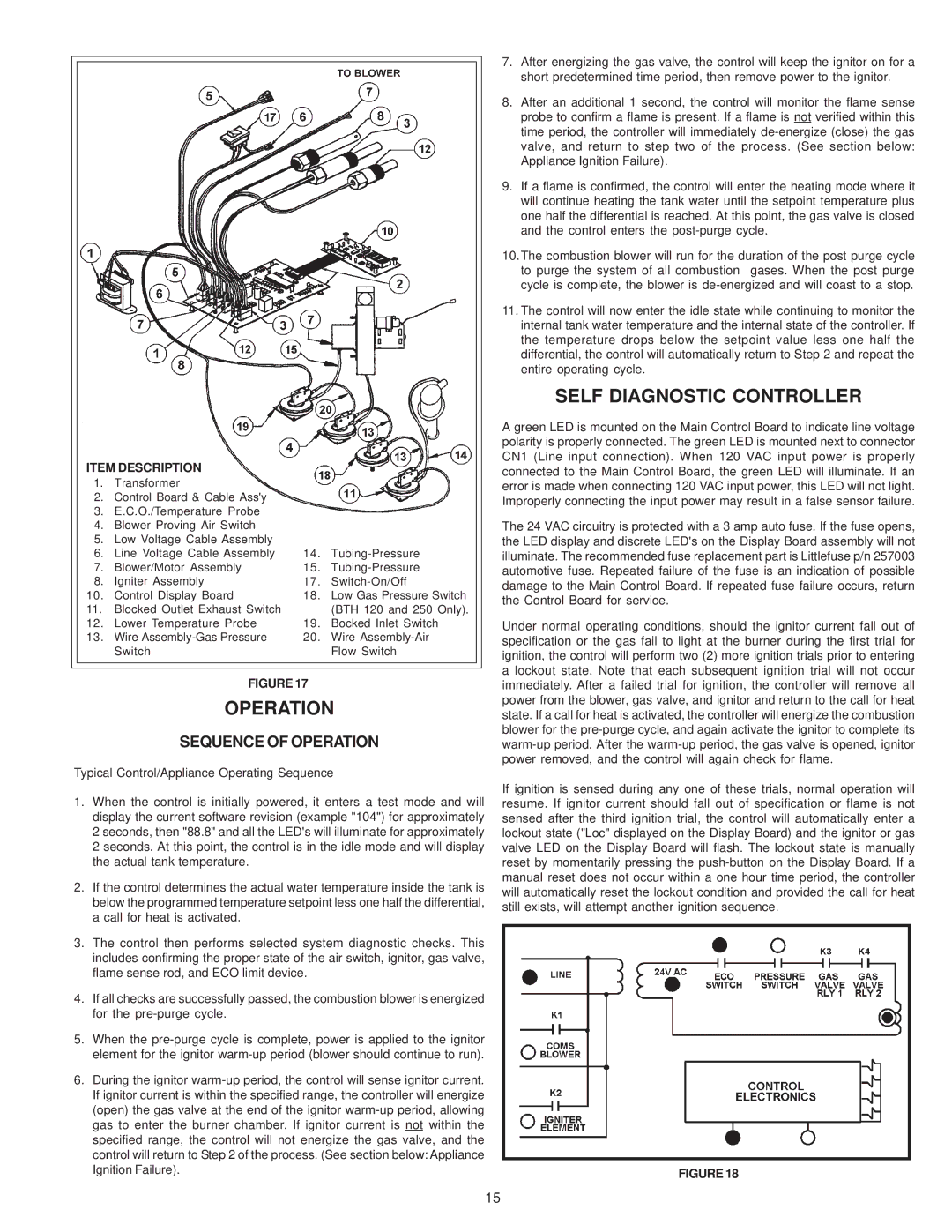ITEM DESCRIPTION
1.Transformer
2.Control Board & Cable Ass'y
3.E.C.O./Temperature Probe
4.Blower Proving Air Switch
5.Low Voltage Cable Assembly
6. | Line Voltage Cable Assembly | 14. | Tubing-Pressure |
7. | Blower/Motor Assembly | 15. | Tubing-Pressure |
8. | Igniter Assembly | 17. | Switch-On/Off |
10. | Control Display Board | 18. | Low Gas Pressure Switch |
11. | Blocked Outlet Exhaust Switch | | (BTH 120 and 250 Only). |
12. | Lower Temperature Probe | 19. | Bocked Inlet Switch |
13. | Wire Assembly-Gas Pressure | 20. | Wire Assembly-Air |
| Switch | | Flow Switch |
FIGURE 17
OPERATION
SEQUENCE OF OPERATION
Typical Control/Appliance Operating Sequence
1.When the control is initially powered, it enters a test mode and will display the current software revision (example "104") for approximately 2 seconds, then "88.8" and all the LED's will illuminate for approximately 2 seconds. At this point, the control is in the idle mode and will display the actual tank temperature.
2.If the control determines the actual water temperature inside the tank is below the programmed temperature setpoint less one half the differential, a call for heat is activated.
3.The control then performs selected system diagnostic checks. This includes confirming the proper state of the air switch, ignitor, gas valve, flame sense rod, and ECO limit device.
4.If all checks are successfully passed, the combustion blower is energized for the pre-purge cycle.
5.When the pre-purge cycle is complete, power is applied to the ignitor element for the ignitor warm-up period (blower should continue to run).
6.During the ignitor warm-up period, the control will sense ignitor current. If ignitor current is within the specified range, the controller will energize (open) the gas valve at the end of the ignitor warm-up period, allowing gas to enter the burner chamber. If ignitor current is not within the specified range, the control will not energize the gas valve, and the control will return to Step 2 of the process. (See section below: Appliance Ignition Failure).
7.After energizing the gas valve, the control will keep the ignitor on for a short predetermined time period, then remove power to the ignitor.
8.After an additional 1 second, the control will monitor the flame sense probe to confirm a flame is present. If a flame is not verified within this time period, the controller will immediately de-energize (close) the gas valve, and return to step two of the process. (See section below: Appliance Ignition Failure).
9.If a flame is confirmed, the control will enter the heating mode where it will continue heating the tank water until the setpoint temperature plus one half the differential is reached. At this point, the gas valve is closed and the control enters the post-purge cycle.
10.The combustion blower will run for the duration of the post purge cycle to purge the system of all combustion gases. When the post purge cycle is complete, the blower is de-energized and will coast to a stop.
11.The control will now enter the idle state while continuing to monitor the internal tank water temperature and the internal state of the controller. If the temperature drops below the setpoint value less one half the differential, the control will automatically return to Step 2 and repeat the entire operating cycle.
SELF DIAGNOSTIC CONTROLLER
A green LED is mounted on the Main Control Board to indicate line voltage polarity is properly connected. The green LED is mounted next to connector CN1 (Line input connection). When 120 VAC input power is properly connected to the Main Control Board, the green LED will illuminate. If an error is made when connecting 120 VAC input power, this LED will not light. Improperly connecting the input power may result in a false sensor failure.
The 24 VAC circuitry is protected with a 3 amp auto fuse. If the fuse opens, the LED display and discrete LED's on the Display Board assembly will not illuminate. The recommended fuse replacement part is Littlefuse p/n 257003 automotive fuse. Repeated failure of the fuse is an indication of possible damage to the Main Control Board. If repeated fuse failure occurs, return the Control Board for service.
Under normal operating conditions, should the ignitor current fall out of specification or the gas fail to light at the burner during the first trial for ignition, the control will perform two (2) more ignition trials prior to entering a lockout state. Note that each subsequent ignition trial will not occur immediately. After a failed trial for ignition, the controller will remove all power from the blower, gas valve, and ignitor and return to the call for heat state. If a call for heat is activated, the controller will energize the combustion blower for the pre-purge cycle, and again activate the ignitor to complete its warm-up period. After the warm-up period, the gas valve is opened, ignitor power removed, and the control will again check for flame.
If ignition is sensed during any one of these trials, normal operation will resume. If ignitor current should fall out of specification or flame is not sensed after the third ignition trial, the control will automatically enter a lockout state ("Loc" displayed on the Display Board) and the ignitor or gas valve LED on the Display Board will flash. The lockout state is manually reset by momentarily pressing the push-button on the Display Board. If a manual reset does not occur within a one hour time period, the controller will automatically reset the lockout condition and provided the call for heat still exists, will attempt another ignition sequence.
FIGURE 18

